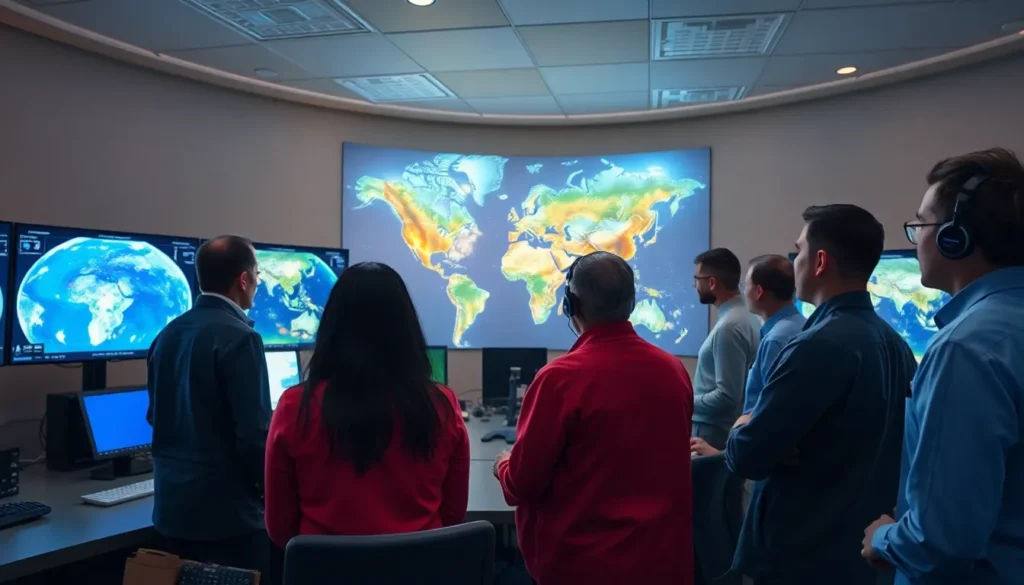Table of Contents
ToggleWeather can be as unpredictable as a cat on a hot tin roof. One minute it’s sunny, and the next, it’s pouring rain like the sky’s hosting a water balloon fight. Staying updated on the weather isn’t just smart; it’s essential for planning your day and avoiding those surprise downpours that ruin perfectly good hairdos.
In a world where the forecast can change faster than a toddler’s mood, having reliable weather updates at your fingertips is crucial. Whether you’re planning a picnic, a road trip, or just deciding if you should wear that snazzy new jacket, accurate weather information can save the day—and your plans. So, let’s dive into the latest and greatest in weather updates, ensuring you’re always one step ahead of Mother Nature’s antics.
Overview of Weather Updates
Weather updates provide essential, real-time information about changing conditions. Accurate forecasts facilitate better planning for daily activities. Meteorologists utilize advanced tools like satellite imagery and radar to track weather patterns. These technologies enhance the precision of alerts for severe weather, including storms or heatwaves.
Timely notifications enable individuals to stay informed, allowing for adjustments in plans. Weather apps deliver personalized updates directly to users’ smartphones. Users can customize settings for location-specific alerts, ensuring they receive relevant information.
Seasonal forecasts also play a critical role in long-term planning. They offer insights into expected temperature ranges and precipitation levels. Communities benefit from preparedness programs related to severe weather events. Awareness of upcoming conditions assists families in securing their properties and taking preventive measures.
Local news stations often share updates alongside expert analyses. Viewers gain a broader understanding of weather impacts on various regions. These discussions emphasize the interconnectedness of climate systems, helping viewers grasp the implications of national weather trends.
Innovation in predictive modeling continues to improve forecast accuracy. Researchers examine historical data to enhance understanding of patterns. They focus on climate change effects, recognizing shifting trends and their significance.
Ultimately, consistent access to reliable weather updates helps people navigate daily life. Knowledge empowers individuals, providing them with necessary information to avoid disruptions. Staying informed enhances safety and comfort during unpredictable weather events.
Importance of Accurate Weather Updates

Accurate weather updates play a crucial role in daily decision-making processes. Reliable forecasts help individuals plan outdoor activities and avoid unexpected weather.
Impact on Daily Life
Weather updates influence various aspects of daily routines. Commuters rely on this information to choose the best routes, ensuring timely arrivals. Parents use forecasts to decide on school activities, while event planners depend on accurate data for scheduling. Travelers benefit from updates to pack appropriate clothing and adjust plans accordingly. Understanding weather conditions allows people to manage risks effectively, minimizing disruptions in their lives.
Economic Implications
Economic activities heavily depend on accurate weather information. Agriculture benefits from timely forecasts that inform farmers about planting and harvesting schedules. Construction projects rely on predictions to avoid delays caused by adverse weather conditions. Transportation and logistics industries utilize weather updates for efficient routing and scheduling, reducing operational costs. Retailers often align inventory with seasonal weather patterns, optimizing sales opportunities. Overall, precise weather updates contribute significant value to various sectors, enhancing productivity and profitability.
Sources for Weather Updates
Weather updates come from various reliable sources, ensuring individuals stay informed about changing conditions.
Traditional Media Outlets
Television stations play a crucial role in disseminating weather forecasts. Newscasters often provide live updates and detailed analyses on local and national weather patterns. Radio broadcasts also offer timely weather reports, making them accessible during commutes. Newspapers maintain dedicated weather sections, typically filled with extended forecasts and regional insights. Such media outlets often employ expert meteorologists who interpret data and communicate it effectively. Their established credibility enhances public trust regarding weather predictions.
Digital Platforms and Apps
Mobile weather applications have transformed how individuals access weather information. Apps deliver personalized alerts directly to users’ smartphones, allowing for immediate awareness of severe weather events. Websites like NOAA and Weather.com provide comprehensive forecasts, real-time radar imagery, and interactive maps. Social media platforms also serve as tools for real-time updates, where meteorologists share forecasts and safety tips. Often, digital platforms allow for customizable notifications, ensuring users receive information that best suits their needs. Each of these resources contributes to a more informed public, enhancing preparedness for weather-related events.
Technology Behind Weather Updates
Weather updates rely on a variety of advanced technologies to provide accurate information. Utilizing sophisticated meteorological tools ensures forecasts remain reliable and timely.
Meteorological Tools and Techniques
Meteorologists employ various techniques to analyze atmospheric data efficiently. This includes computer models that simulate weather patterns, allowing for dynamic forecasting. Observation stations collect data on temperature, humidity, and wind speed, contributing crucial information to forecasts. Predictive algorithms process vast amounts of atmospheric data, improving accuracy over time. Advanced mathematics plays an essential role in refining these forecasts, with simulations that account for numerous variables impacting weather.
Role of Satellites and Radar
Satellites orbiting the Earth capture critical images of weather systems. These images enable forecasters to monitor cloud patterns and storm development in real time. Radar technology detects precipitation, providing information on storm intensity and movement. This data aids in issuing timely warnings for severe weather events. Combining satellite imagery with radar data enhances overall forecasting capabilities, ensuring individuals receive alerts about changing conditions as soon as possible.
Future of Weather Updates
Rapid advancements reshape the future of weather updates. Significant developments enhance forecast accuracy and user experience.
Advancements in Technology
Innovative technologies drive more precise weather predictions. High-resolution satellite imagery now captures real-time atmospheric data. Machine learning algorithms process this information, allowing meteorologists to identify patterns quickly. Enhanced computing power enables simulations that account for numerous variables. These tools result in improved forecasting models that benefit a variety of sectors, including agriculture and transportation. Drones also play a vital role, providing localized data that enhances short-term forecasts. With these advancements, accessing reliable weather information becomes easier for everyone.
Changes in User Engagement
User engagement evolves alongside technological advancements. Increased access to mobile apps offers personalized notifications and real-time updates. Many platforms now incorporate social media, allowing users to share weather experiences with broader audiences. Interactive features attract users, enabling them to access tailored forecasts based on location. Engagement rates rise as people seek instant information on weather conditions. Communities regularly utilize forums to discuss forecasts and share safety tips during severe weather events. As users demand more immediate and interactive content, weather services adapt to meet these expectations.
Staying informed about weather updates is crucial for effective planning and decision-making. With advancements in technology and real-time notifications, individuals can adapt to changing conditions more efficiently. The integration of innovative tools enhances the accuracy of forecasts, providing valuable insights that impact daily life and various industries.
As weather services continue to evolve, users can expect even more personalized and interactive experiences. This ongoing progress ensures that everyone can navigate life’s unpredictability with confidence, minimizing disruptions and maximizing opportunities. Embracing these updates leads to a more prepared and resilient approach to weather-related challenges.




